« MySQL Performance: Why Purge Thread in InnoDB?.. | Main | MySQL Performance: Using Performance Schema »
Monday, 03 May, 2010
MySQL Performance: Improving Stability
Huge performance improvement was came with MySQL 5.5.4, and looking on the following picture it's very easy to see why:
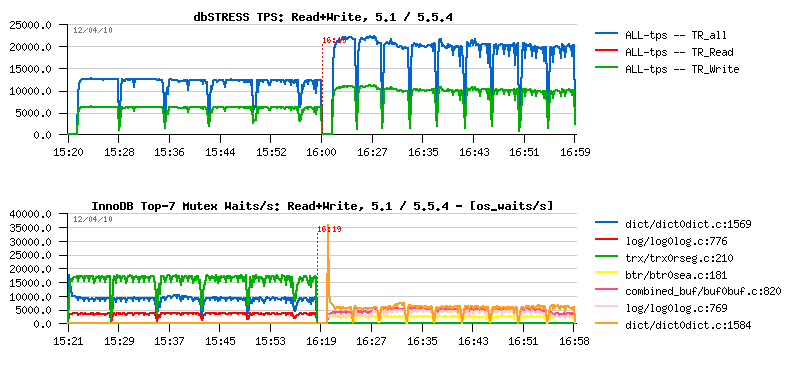
It's a one hour Read+Write dbSTRESS workload with 32 sessions running non-stop on 16 cores server. The left part of the picture corresponds to MySQL 5.1 activity, and the right one to MySQL 5.5.4. The first graph represents TPS levels, and the second one - the mutex waits observed during each test.
Even without going in details you may see how dramatically were reduced mutex waits! And I would say one of the greatest InnoDB features was a compact presentation of the "show innodb mutex" output which gave the way to monitor InnoDB more in depth and understand its contentions on each workload! - it's still not perfect, but anyway a big step ahead :-) and helped a lot to improve 5.5.4.
From the mutex waits graph you may see that the most hot "visible" contention now is on the index mutex (well, the output "file:line" is probably better for debugging rather a normal use - it's one of the things to improve here, just to be more human friendly and show a mutex name instead, as well the code is already there and require a small format changes)..
From the other side, purge lagging is another problem - you may see the same (apples to apples) workload on MySQL 5.1, MySQL 5.5.4 and XtraDB 9.1:

The first graph is still representing the TPS level, and it's interesting to see the potential performance gap between 5.5.4 and XtraDB during the first 10-15 min of test (and if we stop the test here we'll simply miss the next problem and will not see decreasing performance with a time on both engines due purge lagging..). The second graph represents the InnoDB history length, and as you may see it's growing now even faster than before! :-) And the problem is supposed to be fixed with a purge thread.. But let's get a look on one problem at a time :-)
Index Mutex Contention
It'll be great just to get it fixed ;-) But as you know, an simple way to reduce contention on a single mutex is to split this mutex into several ones (so you'll split your contention too, and instead of having say a one single session working at a time - you'll have several sessions working, etc.). And currently MySQL has a nice feature - PARTITIONS! :-) By using partitions on a table having index mutex contentions will simply split this contention by number of partitions! (for example using 3 partitions will physically split your table into 3 tables (even you'll still see it as a single one), and instead of one index mutex you'll have 3 mutexes as well dividing your contention by 3 probably too :-))
However on the next picture you may see the performance impact on 5.5.4 by using 3 partitions on the hottest table during the same Read+Write workload as before:
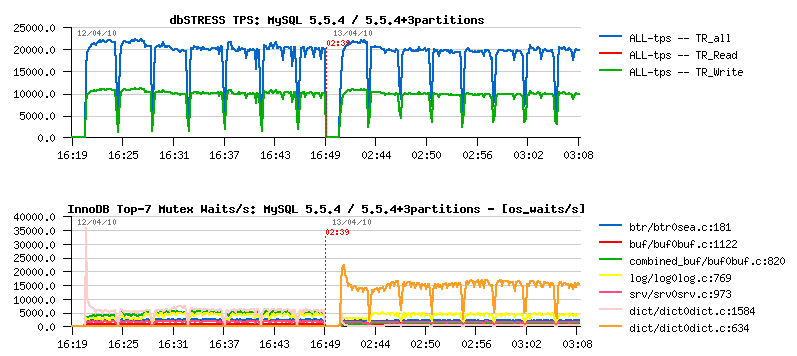
As you may see, curiously TPS level did not change... And we may suppose that partitions would not help here if we did not have improved mutex status within InnoDB and did not see there is another mutex waits jumped to the top and become more hot once we used 3 partitions! (while index mutex was really readuced! - that's why monitoring is so important :-))
What about this new mutex waits? - this is a dictionary lock on stats update. The fix was already proposed by Percona, and is not yet present in the current 5.5.4 tree - but as it's just a one line changes I've tried to see what if it'll be done on 5.5.4:
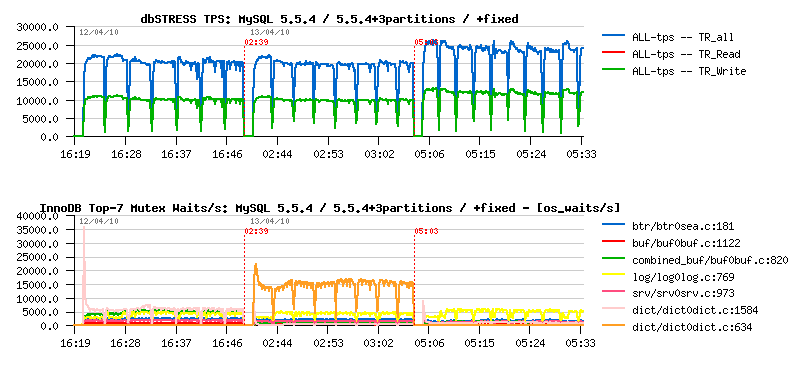
As you can see, the TPS level is improved! (over 20% gain!), and the main "visible" mutex waits are now on the redo logs - which may probably be considered as expected contention for a database in general :-)
But where we're with a history length now?..
Purge Lagging
Now let's get a look on the same workload but from the stability perspective.. Having constantly growing history length is not normal and quite dangerous! As well having periodic performance drops is not better too :-) And the Purge Thread feature is the answer here. But let's look in details how it'll help - the following picture represents the same workload tested on:
- MySQL 5.5.4
- MySQL 5.5.4 +purge thread
- MySQL 5.5.4 +3 partitions
- MySQL 5.5.4 +3 partitions +purge thread
The first graph is TPS, the second one is History length:
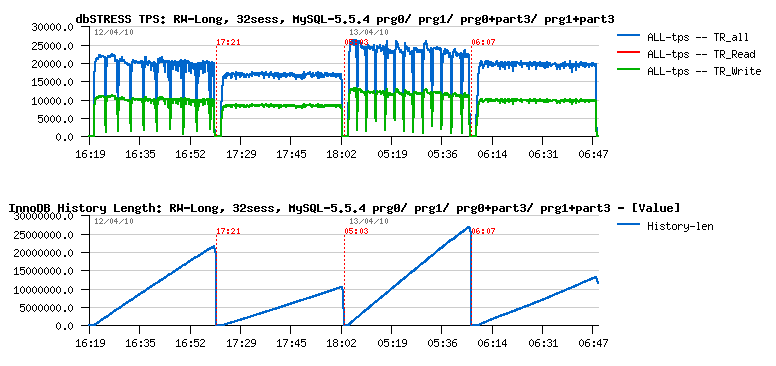
As you may see, Purge Thread brings an important stability to the workload. However a single purge thread is no more enough to follow a purge demand here!..
Currently 5.5.4 implementation allows only one purge thread for the moment. But to analyze a performance impact we may try XtraDB which already allows several purge threads. The following picture represents the same Read+Write workload running on XtraDB 9.1 using 3 partitions and tested:
- without purge thread
- with 1 purge thread
- with 2 purge threads
The first graph represents TPS level, and the second one History length:
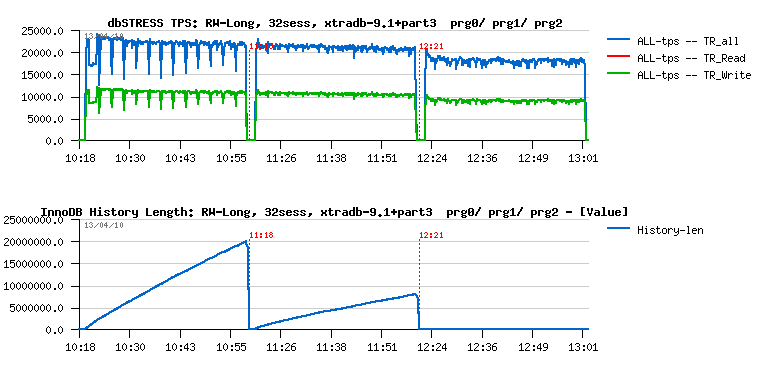
As you may see having 2 purge threads are completely removing purge lagging here! However it's also significantly reducing performance..
Can do we better here?.. - let's try ;-)
For a long time InnoDB has a purge lag configuration option - you can limit purge lagging with innodb_max_purge_lag by setting it to some acceptable level of History length, then once this limit will be reached InnoDB will slightly slow down all arriving DML queries by doing a short sleep (few ms) before processing a query statement. The feature itself is not bad, and many file systems are having a similar solution to throttle a high demand write requests. The only problem with InnoDB purge lag feature that it's broken seems to me, and I've explained why and how to fix it . Now if I apply the fix to XtraDB and see the result ;-)
What I'm interesting here is to compare:
- single purge thread + fixed purge lag
- two purge threads
Of course fixed purge lag without purge thread cannot give us a stable result due all missed maintenance work missed by Master thread (as explained in the previous post ). However, having one purge thread and throttling writes via max purge lag setting may still give a better result than having 2 purge threads..
On the following picture you may see the same Read+Write workload running on XtraDB 9.1 and now comparing:
- XtraDB without purge thread
- XtraDB with a single purge thread
- XtraDB with 2 purge threads
- XtraDB with a single purge thread + fixed max purge lag
The innodb_max_purge_lag was set to 400K here:
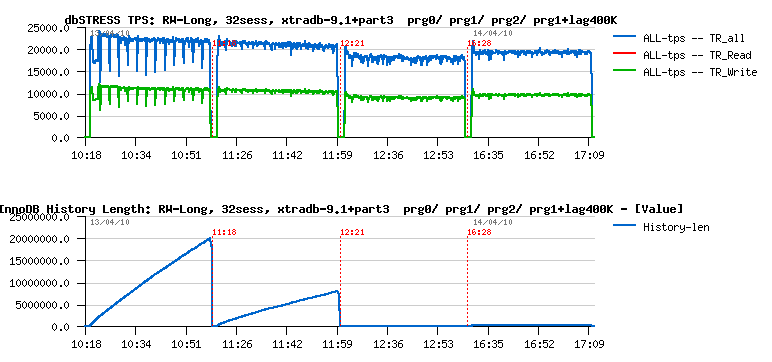
As you see, the tandem of single purge thread + fixed purge lag gives a better result here than 2 purge threads - TPS level is higher while History length is constantly kept under 400K! :-)
Why on my point of view such a solution will be more optimal?
- in many cases one purge thread will be probably just enough
- however when it'll be not enough - your server will still be protected by the max purge lag setting!
As always, many things depends on workload, and your experience may be different of mine.. - but tests and observations will be done, better MySQL performance will be with a time :-)
Any comments are welcome! ;-)
blog comments powered by DisqusNote: if you don't see any "comment" dialog above, try to access this page with another web browser, or google for known issues on your browser and DISQUS..